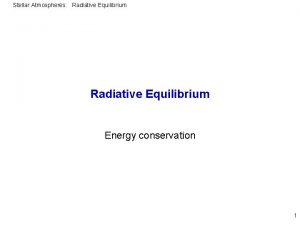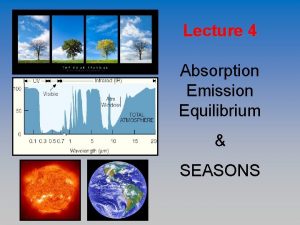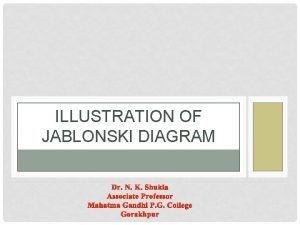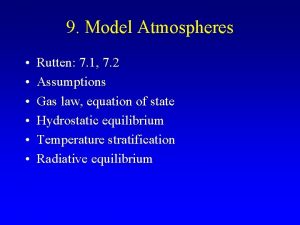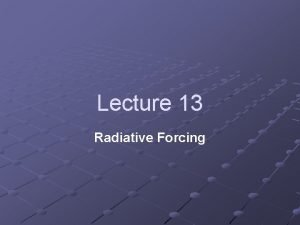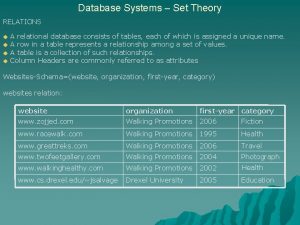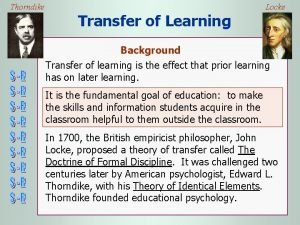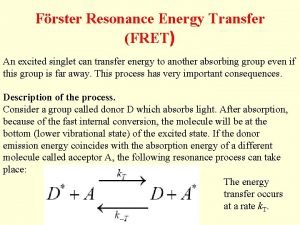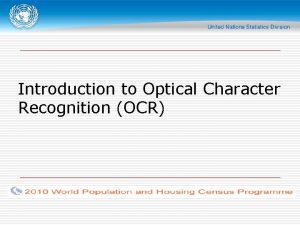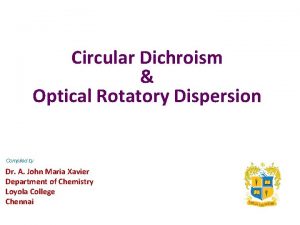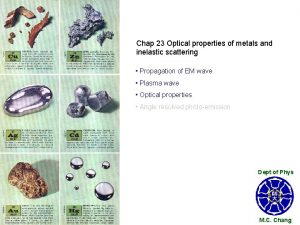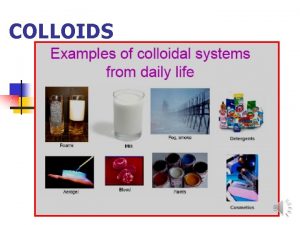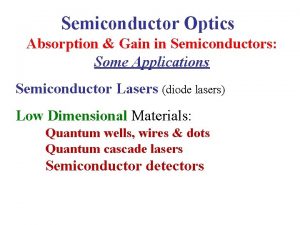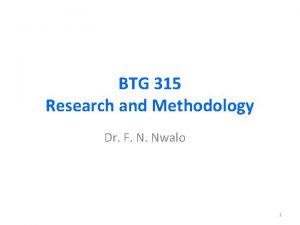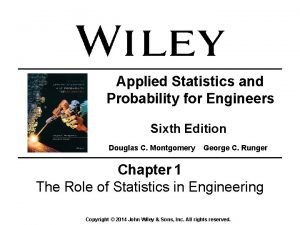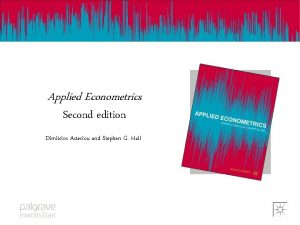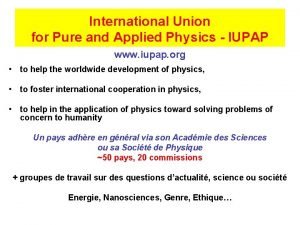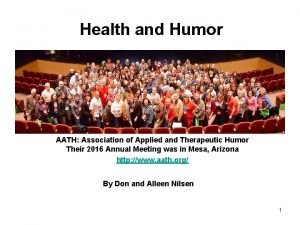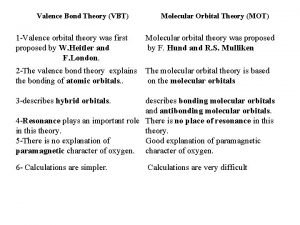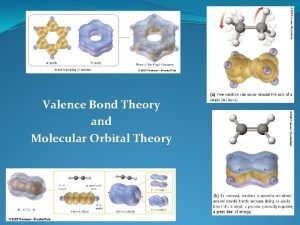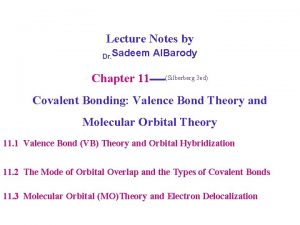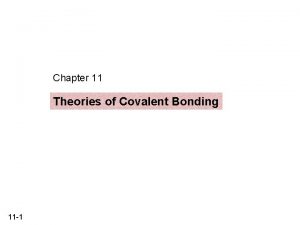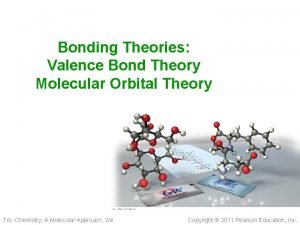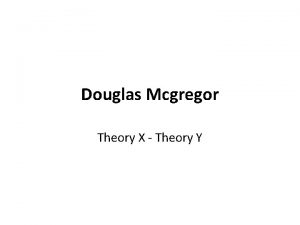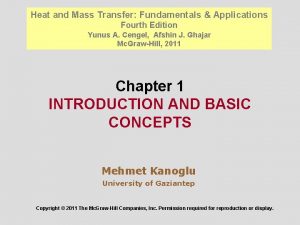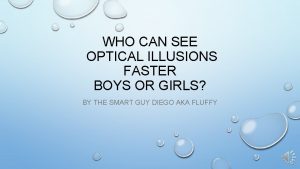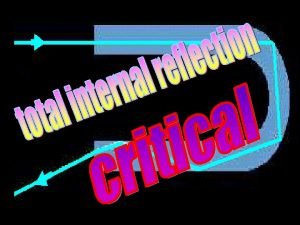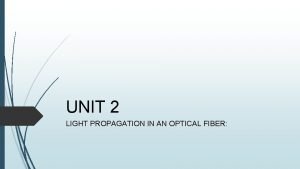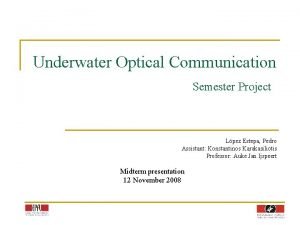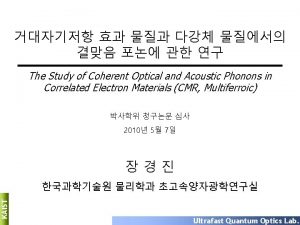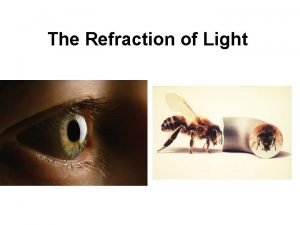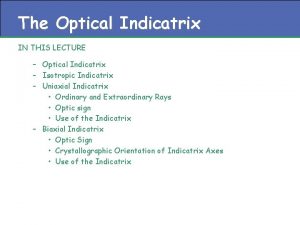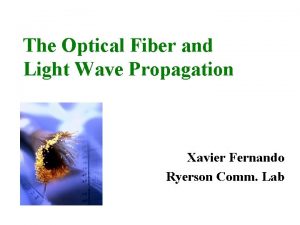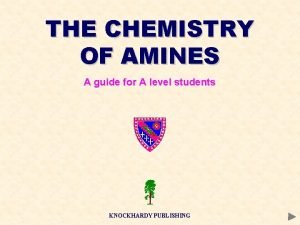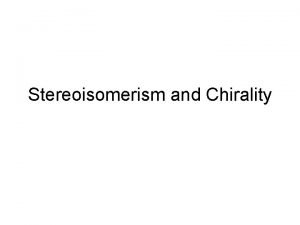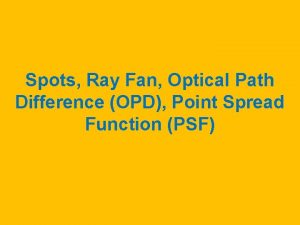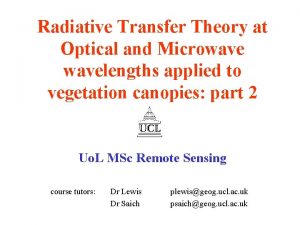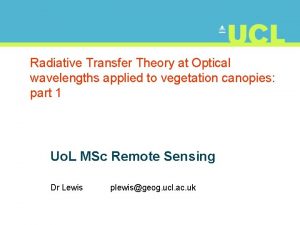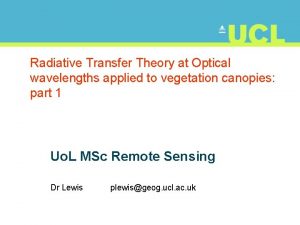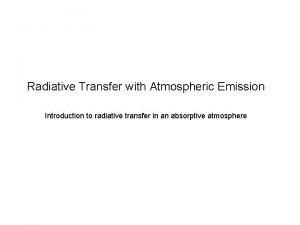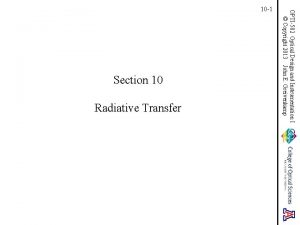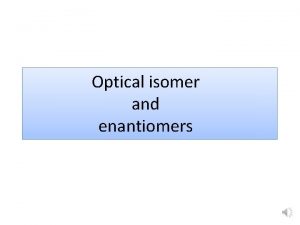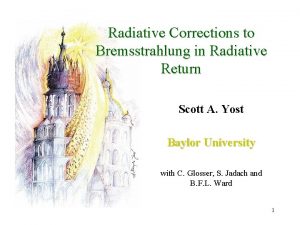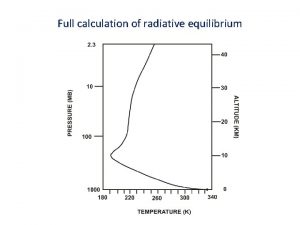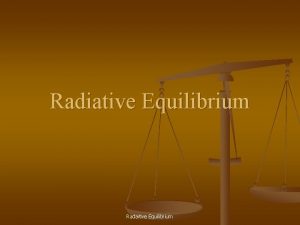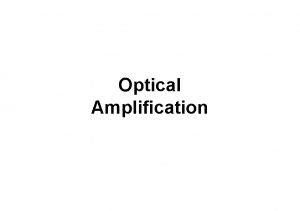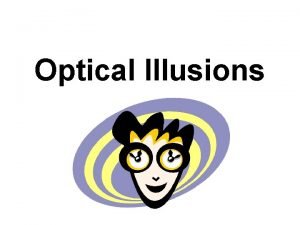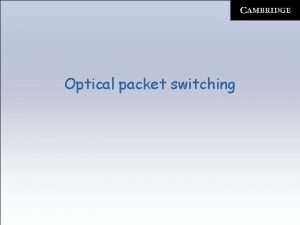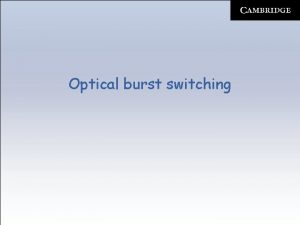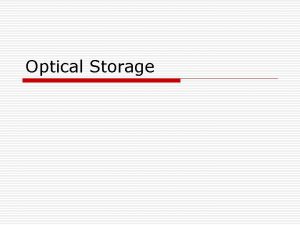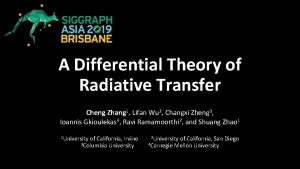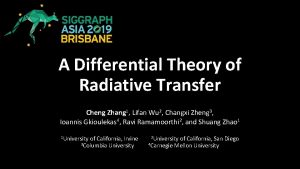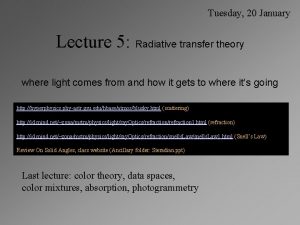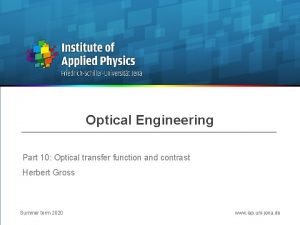Radiative Transfer Theory at Optical and Microwavelengths applied
































































- Slides: 64

Radiative Transfer Theory at Optical and Microwavelengths applied to vegetation canopies: part 1 Uo. L MSc Remote Sensing course tutors: Dr Lewis Dr Saich plewis@geog. ucl. ac. uk psaich@geog. ucl. ac. uk





Aim of this section • Introduce RT approach as basis to understanding optical and microwave vegetation response • enable use of models • enable access to literature

Scope of this section • Introduction to background theory – RT theory – Wave propagation and polarisation – Useful tools for developing RT • Building blocks of a canopy scattering model – canopy architecture – scattering properties of leaves – soil properties

Associated practical and reading • Reading – microwave leaf model • Chuah, H. T. , Lee, K. Y. , and Lau, T. W. , 1995, “Dielectric constants of rubber and oil palm leaf samples at X-band”, IEEE Trans. Geoscience and Remote Sensing, GE-33, 221 -223. – Optical leaf model • Jacquemoud, S. , and Baret, F. , 1990, “PROSPECT: a model of leaf optical properties spectra”, Remote Sensing of Environment, 34, 75 -91. • Practicals investigating leaf scattering – Optical OR microwave

Why build models? • Assist data interpretation • calculate RS signal as fn. of biophysical variables • Study sensitivity • to biophysical variables or system parameters • Interpolation or Extrapolation • fill the gaps / extend observations • Inversion • estimate biophysical parameters from RS • aid experimental design • plan experiments

Radiative Transfer Theory • Approach optical and microwave case at same time through RT – ‘relatively’ simple & well-understood – no other treatment in this way – researchers tend to specialise in either field • less understanding of other field / synergy • Deal with other approaches in later lectures

Radiative Transfer Theory • Applicability – heuristic treatment • consider energy balance across elemental volume – assume: • no correlation between fields – addition of power not fields • no diffraction/interference in RT – can be in scattering – develop common (simple) case here

Radiative Transfer Theory • Case considered: – horizontally infinite but vertically finite plane parallel medium (air) embedded with infinitessimal oriented scattering objects at low density – canopy lies over soil surface (lower boundary) – assume horizontal homogeneity • applicable to many cases of vegetation

Radiative Transfer Theory • More accurate approach is to use Maxwell’s equations • difficult to formulate • will return to for object scattering but not propagation (RT)

Radiative Transfer Theory • More accurate approach is to use Maxwell’s equations • difficult to formulate • will return to for object scattering but not propagation (RT)

Radiative Transfer Theory • More accurate approach is to use Maxwell’s equations • difficult to formulate • use object scattering but not propagation (RT) • essentially wave equation for electric field • k - wavenumber = 2 p/l in air Plane wave

Radiative Transfer Theory • Consider incident Electric-field Ei(r) of magnitude Ei in direction to a position r: • incident wave sets up internal currents in scatterer that reradiate ‘scattered’ wave • Remote sensing problem: – describe field received at a sensor from an area extensive ensemble average of scatterers

Scattering • Define using scattering matrix: • elements polarised scattering amplitudes – for discs: – for needles: • assume scattering in far field

Scattering Bessel function (complex) permittivity of leaf Wavenumber 2 = 4 p 2/l 2 Leaf volume

Scattering Sinc function

Stokes Vector • Can represent plane wave polarisation by , and phase term: • h, v phase equal for linear polarised wave

Stokes Vector • More convenient to use modified Stokes vector:

Stokes Vector • Using this, relate scattered Stokes vector to incident: N. B S 2 so 1/l 4 for discs etc

Stokes Vector • Average Mueller matrix over all scatterers to obtain phase matrix for use in RT

Building blocks for a canopy model • Require descriptions of: – canopy architecture – leaf scattering – soil scattering

Canopy Architecture • 1 -D: Functions of depth from the top of the canopy (z).

Canopy Architecture • 1 -D: Functions of depth from the top of the canopy (z). 1. 2. 3. Vertical leaf area density (m 2/m 3) OR the vertical leaf number density function, Nv(z) (number of particles per m 3) the leaf normal orientation distribution function, (dimensionless). leaf size distribution • defined as: – area to relate leaf area density to leaf number density, as well as thickness. – the dimensions or volume of prototype scattering objects such as discs, spheres, cylinders or needles.

Canopy Architecture • Leaf area / number density – (one-sided) m 2 leaf per m 3 – Nv(z) - number of ‘particles’ per m 3 LAI

Canopy Architecture • Leaf Angle Distribution

Leaf Angle Distribution • Archetype Distributions: · planophile · erectophile · spherical · plagiophile · extremophile

Leaf Angle Distribution • Archetype Distributions:

Leaf Angle Distribution • Elliptical Distribution:

Leaf Angle Distribution • Elliptical Distribution:

Leaf Dimension • RT theory: infinitessimal scatterers – without modifications (dealt with later) • Scattering at microwave depends on leaf volume for given number per unit area – on leaf ‘thickness’ for given LAI • In optical, leaf size affects canopy scattering in retroreflection direction – ‘roughness’ term: ratio of leaf linear dimension to canopy height also, leaf thickness effects on reflectance /transmittance

Leaf Dimension • RT theory: infinitessimal scatterers – without modifications (dealt with later) • Scattering at microwave depends on leaf volume for given number per unit area – on leaf ‘thickness’ for given LAI • In optical, leaf size affects canopy scattering in retroreflection direction – ‘roughness’ term: ratio of leaf linear dimension to canopy height also, leaf thickness effects on reflectance /transmittance

Canopy element and soil spectral properties • Scattering properties of leaves – scattering affected by: • Leaf surface properties and internal structure; • leaf biochemistry; • leaf size (essentially thickness, for a given LAI).

Scattering properties of leaves • Leaf surface properties and internal structure optical Specular from surface Smooth (waxy) surface - strong peak hairs, spines - more diffused

Scattering properties of leaves • Leaf surface properties and internal structure optical Diffused from scattering at internal air-cell wall interfaces Depends on total area of cell wall interfaces Depends on refractive index: varies: 1. 5@400 nm 1. 3@2500 nm

Scattering properties of leaves • Leaf surface properties and internal structure optical More complex structure (or thickness): - more scattering - lower transmittance - more diffuse

Scattering properties of leaves • Leaf surface properties and internal structure microwave Thickness (higher volume) - higher scattering

Scattering properties of leaves • Leaf biochemstry

Scattering properties of leaves • Leaf biochemstry

Scattering properties of leaves • Leaf biochemstry

Scattering properties of leaves • Leaf biochemstry

Scattering properties of leaves • Leaf biochemstry – pigments: chlorophyll a and b, a-carotene, and xanthophyll • absorb in blue (& red for chlorophyll) – absorbed radiation converted into: • heat energy, flourescence or carbohydrates through photosynthesis

Scattering properties of leaves • Leaf biochemstry – Leaf water is major consituent of leaf fresh weight, • around 66% averaged over a large number of leaf types – other constituents ‘dry matter’ • cellulose, lignin, protein, starch and minerals – Absorptance constituents increases with concentration • reducing leaf reflectance and transmittance at these wavelengths.

Scattering properties of leaves • Optical Models – flowering plants: PROSPECT

Scattering properties of leaves • Optical Models – flowering plants: PROSPECT

Scattering properties of leaves • Leaf water

Scattering properties of leaves • Leaf water · PROSPECT: · leaf water content parameterised as equivalent water thickness (EWT) · approximates the water mass per unit leaf area. · related to volumetric moisture content (VMC, Mv) (proportionate volume of water in the leaf) by multiplying EWT by the product of leaf thickness and water density.

Scattering properties of leaves • Microwave: – water content related to leaf permittivity, e. Offset factor Volume fractions

Scattering properties of leaves • Microwave: – water content related to leaf permittivity, e. Frequency / GHz

Scattering properties of leaves • leaf dimensions – optical • increase leaf area for constant number of leaves - increase LAI • increase leaf thickness - decrease transmittance (increase reflectance) – microwave • leaf volume dependence of scattering – volume for constant leaf number – thickness for constant leaf area

Scattering properties of soils • Optical and microwave affected by: – soil moisture content – soil type/texture – soil surface roughness.

soil moisture content • Optical – effect essentially proportional across all wavelengths • enhanced in water absorption bands

soil moisture content • Microwave – increases soil dielectric constant • effect varies with wavelength • generally increases volume scattering – and decreases penetration depth

soil texture/type • Optical – relatively little variation in spectral properties – Price (1985): • PCA on large soil database • 99. 6% of variation in 4 PCs – Stoner & Baumgardner (1982) defined 5 main soil types: • • • organic dominated minimally altered iron affected organic dominated iron dominated • Microwave - affects dielectric constant

Soil roughness effects • Simple models: – as only a boundary condition, can sometimes use simple models • e. g. Lambertian • e. g. trigonometric (Walthall et al. , 1985)

Soil roughness effects • Smooth surface: – Fresnel specular reflectance/transmittance – can be important at microwave • due to double bounce in forest – can be important at optical for viewing in close to specular direction – Using Stokes vector:

Soil roughness effects • Smooth surface:

Soil roughness effects • Low roughness: – use low magnitude distribution of facets • apply specular scattering over distribution – general effect: • increases angular width of specular peak

Soil roughness effects • Rough roughness: – optical surface scattering • clods, rough ploughing – use Geometric Optics model (Cierniewski) – projections/shadowing from protrusions

Soil roughness effects • Rough roughness: – optical surface scattering • Note backscatter reflectance peak (‘hotspot’) • minimal shadowing • backscatter peak width increases with increasing roughness

Soil roughness effects • Rough roughness: – volumetric scattering • consider scattering from ‘body’ of soil – particulate medium – use RT theory (Hapke - optical) – modified for surface effects (at different scales of roughness)

Summary • Introduction – Examined rationale for modelling – discussion of RT theory – Scattering from leaves – Stokes vector/Mueller matrix • Canopy model building blocks – canopy architecture: – leaf scattering: – soil scattering: area/number, angle, size spectral & structural roughness, type, water
 Radiative equilibrium temperature
Radiative equilibrium temperature Radiative equilibrium temperature
Radiative equilibrium temperature What is the jablonski diagram
What is the jablonski diagram Radiative equilibrium temperature
Radiative equilibrium temperature Radiative forcing definition
Radiative forcing definition A disturbance that transfers energy is called
A disturbance that transfers energy is called Set theory in dbms
Set theory in dbms Theory of probability in surveying
Theory of probability in surveying Applied learning theory
Applied learning theory Theory of learning
Theory of learning Transfer of learning theory
Transfer of learning theory Transfer of learning theory
Transfer of learning theory Energy transfer theory
Energy transfer theory Optical mark recognition advantages and disadvantages
Optical mark recognition advantages and disadvantages Optical fibre cable advantages and disadvantages
Optical fibre cable advantages and disadvantages Circular dichroism and optical rotatory dispersion
Circular dichroism and optical rotatory dispersion Optical properties of metals and nonmetals
Optical properties of metals and nonmetals Tyndall effect is an optical property
Tyndall effect is an optical property Semiconductor
Semiconductor Communication with the outside world
Communication with the outside world Optical switching and networking
Optical switching and networking The difference between basic research and applied research
The difference between basic research and applied research Contrast applied research and basic research
Contrast applied research and basic research Applied vs fundamental research
Applied vs fundamental research Basic and applied research
Basic and applied research Applied statistics and probability for engineers download
Applied statistics and probability for engineers download Elearning adveti
Elearning adveti Toxicology and applied pharmacology
Toxicology and applied pharmacology Fu foundation school of engineering
Fu foundation school of engineering Applied econometrics by dimitrios asteriou pdf
Applied econometrics by dimitrios asteriou pdf Gradated rhythm in architecture
Gradated rhythm in architecture Applied linguistics
Applied linguistics Uc college of engineering and applied science
Uc college of engineering and applied science International union of pure and applied physics
International union of pure and applied physics Association for applied and therapeutic humor
Association for applied and therapeutic humor Theory x and theory y
Theory x and theory y Continental drift theory and plate tectonics theory
Continental drift theory and plate tectonics theory Plate tectonics vs continental drift
Plate tectonics vs continental drift Neoclassical organization theory
Neoclassical organization theory Motivation in group formation
Motivation in group formation Employees who are strongly power-motivated are driven
Employees who are strongly power-motivated are driven Plate and rate theory of chromatography
Plate and rate theory of chromatography Lien theory vs title theory
Lien theory vs title theory X and y theory
X and y theory Game theory and graph theory
Game theory and graph theory Molecular orbital theory was produced by: *
Molecular orbital theory was produced by: * Vbt theory
Vbt theory Theory x and theory y
Theory x and theory y Valence bond theory and molecular orbital theory
Valence bond theory and molecular orbital theory Theories of covalent bonding
Theories of covalent bonding Hcn molecular orbital diagram
Hcn molecular orbital diagram Which of the following is a theory x assumption?
Which of the following is a theory x assumption? Application of heat transfer
Application of heat transfer Optical illusions science fair projects
Optical illusions science fair projects A ray of light travels from an optical denser
A ray of light travels from an optical denser V number in optical fiber
V number in optical fiber Underwater optical control
Underwater optical control Optical vs acoustic phonons
Optical vs acoustic phonons In a curved optical fiber light
In a curved optical fiber light Isotropic indicatrix
Isotropic indicatrix Skew rays in optical fiber
Skew rays in optical fiber Amino acid optical isomers
Amino acid optical isomers Precision optical blanks
Precision optical blanks Constitutional isomer
Constitutional isomer Opd fan
Opd fan
